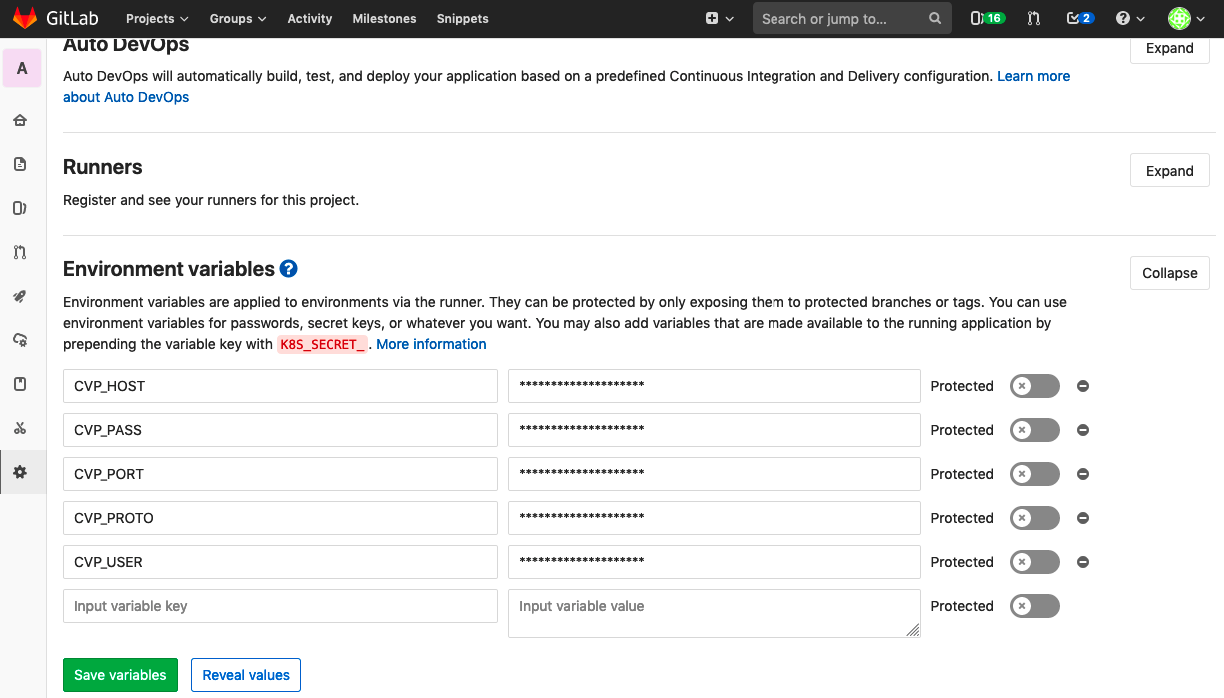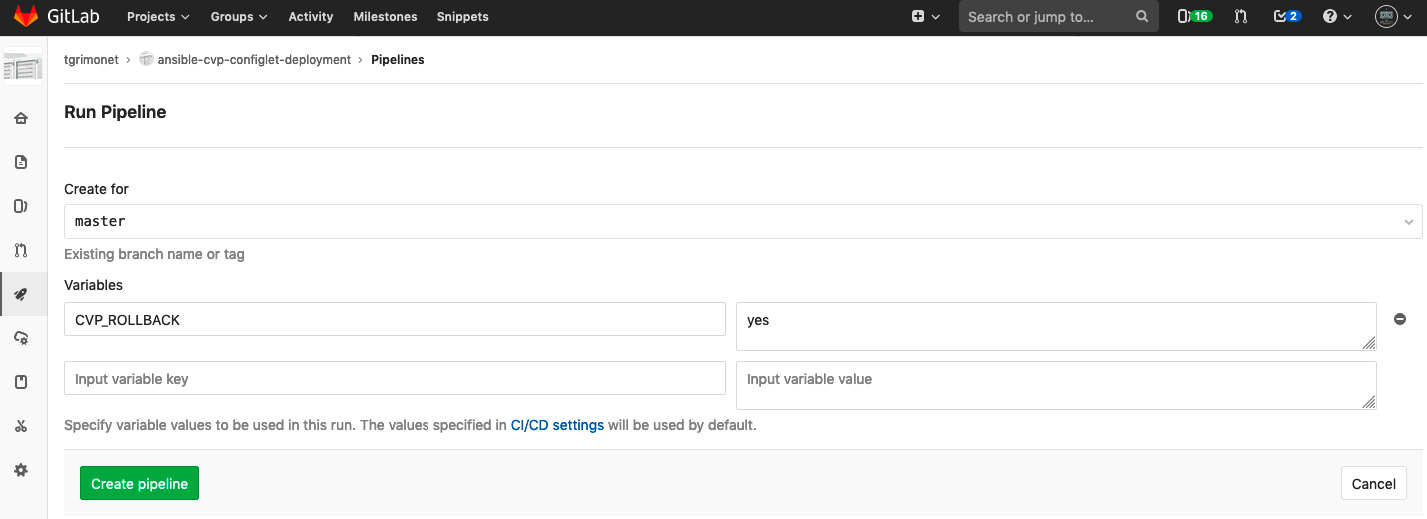Warning - REPO DEPRECATED, an ansible-cvp module is developed by Arista and will provide more feature than this demo repository.
This content demonstrate how to use ansible to build configlet for devices and CVP to deploy changes with control and visibility.
Using CVP to deploy configlet to devices give us some more interesting opportunity:
- Everything is available in telemetry: your changes can be correlate with status returned by your devices
- CVP will create tasks and calculate diff to apply to running config. And it is easily readable within CVP interface.
- CVP will provide an RBAC mechanism which is not available natively with Ansible.
- And last but not least: CVP can act as a management gateway with no need to expose all your devices
This demo has been built using these requirements:
- Ansible framework for template management.
- CVP Configlet Manager to deploy configlet on CVP.
- Arista Demo Cloud to provide Cloudvision server and EOS endpoints.
In this demo, Ansible only provides a basic jinja2 rendering with one group and very basic content. So you can basically change ansible content by any tools / python scripts to generate your content as long as output is similar to what we describe below.
Ansible content will do 3 different tasks:
- Create configlet with vlans to configure.
- Create a
JSONfile to deploy this configlet (assuming it is a new configlet). - Create a
JSONfile to manage manual rollback after the demo.
Once Ansible has generated content, cvp-configlet-manager has to be use to deploy configlet and create a change-control
To use this demo, you have to install requirements with following commands:
# Ansible librairies
$ pip install -r requirements.txt
# cvprac and cvp-configlet-uploader
## cvprac@develop is required as CVP change-control API updates is not in master.
## Once it will be merged, command will no longer be required
$ pip install git+https://github.com/aristanetworks/cvprac.git@develop
# Python script to upload configlet & create change-control
$ pip install git+https://github.com/titom73/arista-cvp-scripts.gitIn the meantime, you have to build your own topology with a CVP server or rely on an Test Drive. As everything is based on ATD, it is recommended to use an intstance as everything has been packaged such as device name, groups, and content
This demo will create a list of vlans on a set of leaf devices.
it is required to configure some variables first to create connection to CVP server. All these elements are configured in file env.settings
Mandatory fields:
CVP_HOST: IP address of your CloudVision server. Should be updated to match your environment or your ATD serverCVP_PORT: CVP Port (set to 443). If using ATD or default setup, this value should not have to be updatedCVP_PROTO: HTTP or HTTPS (set to https). If using ATD or default setup, this value should not have to be updatedCVP_USER: Your CVP username. If using ATD, this value should not have to be updatedCVP_PASS: Your CVP password. If using ATD, this value should not have to be updated
Optional Field:
CVP_CC_APPLY: (Optional ) if set to true, change-control will be scheduling to be executed 3 minutes after its creationCVP_CC_TZ: (optional) Timezone to schedule change-control.CVP_CC_COUNTRY: (optional) Country code to use in change-control scheduling
Once you have updated this file, just run following command:
$ source env.settings
CVP Uploader configured with
- server: 13.56.254.40
- username: aristaInformation about vlans and devices to use for deployment is defined in group_vars/leaf folder.
Data structure we use to define vlans is the following:
---
customers:
devices: # List of devices where to deploy configlet
- 'leaf1'
- 'leaf2'
- 'leaf3'
dict: # List of customers
cust01: # Customer name
vlans: # List of vlan-ids configured for customer
- 10
- 11
- 12
- 13You can use vlans already configured or change them to match your demo.
Build phase is a basic ansible playbook to run:
ansible-playbook playbook.build.customers.vlans.yml -i inventory.ini
PLAY [Build] ********************************************************************
TASK [remove host build temp directory] *****************************************
changed: [leaf1 -> localhost]
TASK [create host build temp directory] *****************************************
changed: [leaf1 -> localhost]
PLAY [Build Configlets] *********************************************************
TASK [configlet.customers.vlans : Generate Configlet for customers VLANs.] ******
changed: [leaf1]
TASK [configlet.customers.vlans : Build JSON to deploy configlet] ***************
changed: [leaf1]
TASK [configlet.customers.vlans : Build JSON to rollback configlet] *************
changed: [leaf1]
PLAY RECAP **********************************************************************
leaf1 : ok=5 changed=5 unreachable=0 failed=0You can check result in configlets folder:
$ tree -L 2
.
├── README.md
├── configlets
│ ├── configlet.customers.vlans.conf
│ ├── customers.vlans.actions.json
│ └── rollback.customers.vlans.actions.json
├── env.settings
Once content has been created, you can use cvp-configlet-uploader to deploy content to CloudVision:
$ cvp-configlet-manager -j configlets/customers.vlans.actions.json
--------------------
2019-04-08 13:01:16 INFO configlet Customers VLANs configlet is going to be\
created configlets/configlet.customers.vlans.conf
2019-04-08 13:01:17 INFO Connected to 13.56.254.40
2019-04-08 13:01:17 INFO *************
2019-04-08 13:01:17 INFO Start working with configlets/configlet.customers.vlans.conf
2019-04-08 13:01:17 ERROR GET: https://13.56.254.40:443/web/configlet/\
getConfigletByName.do?name=configlet.customers.\
vlans.conf : Request Error: Entity does not exist
2019-04-08 13:01:17 WARNING Configlet NOT found on 13.56.254.40
2019-04-08 13:01:17 INFO Start to create new configlet: \
configlets/configlet.customers.vlans.conf
2019-04-08 13:01:17 INFO Version [u'2018', u'2', u'2']
2019-04-08 13:01:17 INFO Setting API version to v2
2019-04-08 13:01:19 INFO Create configlet configlet.customers.vlans.conf
2019-04-08 13:01:19 INFO Apply configlet configlet.customers.vlans.conf to leaf1
2019-04-08 13:01:20 INFO Apply configlet configlet.customers.vlans.conf to leaf2
2019-04-08 13:01:21 INFO Apply configlet configlet.customers.vlans.conf to leaf3
2019-04-08 13:01:22 INFO Configlet configlet.customers.vlans.conf\
has been applied to all devices
2019-04-08 13:01:22 WARNING deploy option has not been set for the configlet
2019-04-08 13:01:22 WARNING --> doing nothing
--------------------
2019-04-08 13:01:22 INFO Wait 10 sec before next action
2019-04-08 13:01:32 INFO Implementation in progress -- expect some issues
2019-04-08 13:01:33 INFO Connected to 13.56.254.40
2019-04-08 13:01:33 INFO start change-control creation
2019-04-08 13:01:33 INFO change control must be executed manually
2019-04-08 13:01:33 INFO Building a dictionary of changes
2019-04-08 13:01:33 INFO !CVP informs us that change-control creation is success (id 23)
2019-04-08 13:01:33 INFO Wait 10 sec before next action
This command will do following actions:
- Deploy configlet from
configlets/configlet.customers.vlans.confto CloudVision server - Attach this configlet to devices listed in group_vars/leaf/vlan_customers.yaml if they are configured on CVP
- Create tasks on CVP for configlet deployment
- Create a change control for all these tasks with a pre/post snapshot (Default snapshot defined in ATD)
By default this command do not execute any change-control nor schedule change-control.
After CVP deployment, you can connect to your CVP server to get result
- Configlet:
https://${{CVP_HOST}}/web/#/configlet - Tasks:
https://${{CVP_HOST}}/web/#/task - Change Control:
https://${{CVP_HOST}}/web/#/changecontrol
And finally, execute change-control manually
Ansible generate a file to create a rollback to instruct CVP to delete configlet and create a change control to remove this configlet output from devices.
Just use following command:
$ cvp-configlet-uploader -j configlets/rollback.customers.vlans.actions.json
Demo can be run with a CI/CD approach with no action from local laptop using any runners like gitlab-runners, travisci or Jenkins.
In this repository, we will provide configuration for gitlab-runners but it can be replicated on any 3rd part CI tool like Jenkins or tracis-ci
- Fork the repository in your namespace
- Go to settings/ci_cd in your project and configure Environment Variables:
Mandatory Entries
- CVP_HOST= < YOUR CVP IP Address >
- CVP_PORT = 443
- CVP_PROTO = https
- CVP_USER = arista
- CVP_PASS = arista
Optional Entries
- CVP_CC_APPLY= true
- CVP_CC_TZ= Etc/UTC (or any other suitable timezone)
- CVP_CC_COUNTRY= UK (or any other country code that suit you)
Note: Arista runners are configured using ETC/UTC timezone. So it is not recommended to change this setting unless you know how to fix potential issue.
- Create and run a pipeline under pipelines
Then you can monitor workflow execution. This workflow is a multi-stage approach with following stages:
- Validation: Just check ansible code to be sure there is no typo
- Deploy: Execute Ansible and Python to deploy configlet.
- If all tasks are green, you can connect to CVP and check your change control
Note: if you scheduled change-control execution, just wait 3 minutes and you will get a completed change-control
- Check changes after execution
If you did not schedule the change-control, first run this action.
Like any other change-control, you can compare result of your snapshot and see if change is coherent or break your network
A stage is available in CI/CD workflow to manage configuration rollback and to remove configlet from server. To run this task, start a new pipeline with following varirable:
CVP_ROLLBACK=yes
By default, this task is scheduled to be executed 3 minutes after you deploy this change. Hence, it is just a click and forget approach.
Project is published under BSD License.
Please open an issue on Github this is the fastest way to get an answer.
Contributing pull requests are gladly welcomed for this repository. If you are planning a big change, please start a discussion first to make sure we’ll be able to merge it.









